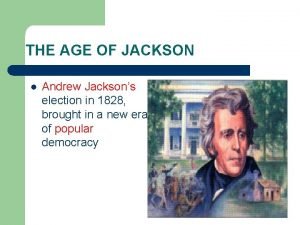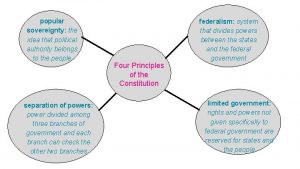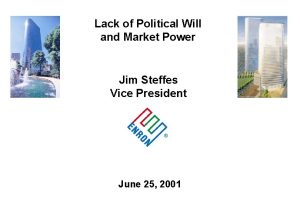Lack of Political Will Market Power June 25
























- Slides: 24

Lack of Political Will & Market Power June 25, 2001

Lack of Political Leadership • Davis’s Legacy to California Energy Markets is marked by Costly Actions and In-Actions – Costly Action 1: Davis pushes FERC for Price Caps of Nov. 1 lead to delay of much needed capacity, that failed to come online during Summer 2001 NERC projects that California would be deficient by about 3, 600 MW this summer This shortfall would have been reduced by 10 -20% had price caps not been provided for

Lack of Political Leadership – Costly In-Action 2: CPUC makes it difficult, if not impossible, for utilities to forward contract for significant amounts of power leading to: • load serving utilities paying highly escalated cost of power; and • DWR contracting for power at prices significantly above the prices available during early Summer of 2000 – Costly In-Action 3: Cost overruns due to the failure of CPUC to recognize the serious fundamental demandsupply imbalance faced by utilities and their consumers • Increasing consumer prices by 20% in July 2000, instead of 10% in January 01 and 30% in June 01 would have – decreased demand; and – lowered wholesale prices

Lack of Political Leadership • CPUC rejected last year offer “Last summer, Houston-based Enron and several other firms offered to sell power to California's utilities for just five years at about $50 a megawatt -hour” (Source: L. A. Times, June 13, 2001) • California releases long-term power deals… “the state will be paying an average price of $69/MWh over the next 10 years” (Source: Platts: Electric Power Daily, June 18, 2001)

Costly Action / In-action Options before the state, fall of 2000: 1. Enter into long-term contracts in 2000, instead of 2001 2. Buy on the spot market in 2001 3. Not to go in for Price Caps in Nov. 2000 4. Impose tariff increases & conservation measures in 2000 5. Bring the QFs back into generation earlier on (Jan ‘ 01) 6. Not to incur Stranded costs due to long-term contracts this year 7. Concentrate on correcting the demand-supply imbalance, instead of spending time on market power studies

Long-term contracts & Spot Market Purchases • Long-term contracts were available to the state, in fall 2000, at $45, $50, $55 /MWh. However, the state chose to ignore such opportunities and paid anywhere between $12 to $19 billion instead over the period 2000 -2010* • Instead of entering into long-term contracts this year if the state had resorted to spot market purchases for atleast 25% of the total contracted for, the state would have saved $6 billion over the period 2001 -2010 (Based on forward price curves) Refer appendix 1 & 2 for more details *This is if one were to assume that the entire contracted value as of today were purchased in long-term contracts last year. If the state had entered into contracts last year, for atleast 25% of the total contracted this year, the state could have saved close to $5 billion, over this period

Price Caps • The price cap on the California Power Exchange day-ahead market was lowered from $750 per kilowatthour to $250 per kilowatthour as the summer progressed. By August, average hourly exports were 3000 megawatts greater than in May 2000. As a result, net imports in August 2000 were 3500 megawatts below 1999 levels Source: Federal Energy Regulatory Commission. Staff Report on U. S. Bulk Power Markets: Part I (November 2000) • The current price caps are likely to result in nearly 113 hours of rolling outages this summer, for Californian residents, with an average size of approximately 1900 megawatts. This would affect approx. 1. 4 million households • (Source: “The Impact of Wholesale Electricity Price Controls on California Summer Reliability, June 2001, U. S. Department of Energy)

Tariff increases and demand elasticity* • Assuming the same demand elasticity and conservation pattern in 2000 as in 2001, saving of about $7. 8 billion could have been made over the period 2000 -10 if tariff increases were imposed in 2000 • If lower demand elasticity and conservation patterns be assumed in 2000 vis-à-vis 2001, these savings marginally reduce to $7. 4 over the same period For more details refer Appendix 3 * Source: DWR Report

QF Generation* • January & April 01 DWR purchases power from the spot market for prices higher than $300/MWh • Utilities Edison and PG&E withhold payments to the QFs, amounting to $529 million and $387 Million resp. , as of Jan 31, 2001 (Source: L. A. Times 02/10/2001) • Many QFs go offline due to change in the formula used for arriving at gas prices to be paid by them and demand payments of $125/MWh (Source: to be quoted ? ? ? ) • Had DWR restored QF generation instead of resorting to the spot market purchases it could have saved anywhere between $1. 0 billion and $1. 1 billion. (For more details refer Appendix 4)

Stranded Costs • Based on a forecasted Price Curve (SP 15) one can conclude that the long-term contracts entered into by DWR have resulted in about $21 billion in stranded costs, vis-à-vis purchases from the market (Refer to Appendix 5 for more detail Appendix to be attached shortly)

DMA-ISO Conclusions Gouging of excess payments by Energy suppliers / traders in the California Markets, during the period May November 2000

DMA Studies • The Wolak study arrives at a measure for measuring market power and concludes that total payments of $785 million in excess of competitive levels were made • The DMA studies compare actual bids submitted by certain suppliers on an aggregate basis and individually against competitive benchmarks established by DMA. • Sheffrin of the DMA identifies a list of suppliers who had exercised market power and arrives at total excess payments of $505. 2 Million • Hildebrandt of the DMA in his revised analysis, dated June 19 2001, arrives at an an aggregate estimate of $8. 9 billion

Drawbacks of the studies • Fail to treat the entire Western Interconnection region as an integrated market – an utter disregard to supply and demand conditions outside of California • Arbitrary heat rate-based cost standard for importers that does not reflect resource scarcity in the Pacific Northwest • Total disregard for opportunity costs that impact competitive market prices in California

Drawbacks in the studies • Unrealistic assumptions regarding cost of new power Conclusion • Instead of placing attention to programs that would help alleviate the supply-demand imbalance, the ISO’s call for greatly expanded price controls will deter investments in new generation

Issues • California’s own public utilities are more likely to exercise market power as they have greater maneuverability (in terms of volumes of supplies) than anybody else to game the market • “A $1 billion alleged overcharge by Sempra Energy Trading Corp. and San Diego Gas & Electric, both units of Sempra Energy (SRE), was deleted by ISO, according to documents obtained by Dow Jones Newswires”. The ISO wouldn’t explain the reason it erased the company’s alleged overcharge. (Source: Dow Jones Energy Service, 06/22/2001) • ISO substantially reduces the “monopoly rents” earned by BPA, based on information supplied to it by the latter.

Numberspeak • Less than 19% of the excess payments made have gone to Texas-based suppliers / traders (Source: Decoded Sheffrin Study) • Close to 75% of the excess payments made have gone to Non-Texas-based suppliers (Source: DMA Studies ) • A weighted analysis of the excess payments by the volumes transacted in that year* reveal that the actual share of Enron in terms of excess payments is about 1 % (Refer Appendix 6) • This indicates that the allegations made against Enron are uncalled for * The volume shares for 1999 have been used due to lack of adequate information for 2000

ISO’s Statements • President and CEO, CA ISO acknowledges that “the findings contained therein (DMA Studies) were preliminary and that they were based on assumptions derived from information available to the ISO at that time” • (Source: Letter from Terry M. Winter to Stephen Oliver (VP, BPA)

Conclusions • ISO admits that its findings are preliminary • Subsequent reassessment by ISO of the excess payments made to BPA casts some doubts on the methodology employed • ISO should pay greater attention to alleviating the supply-demand situation than to seeking price caps • Allegations made by the ISO are uncalled for

Appendix 1

Appendix 2

Appendix 3

Appendix 4

Appendix 5 To be checked if we can use this price curve

Appendix 6
 Leader follower challenger nicher
Leader follower challenger nicher Requirements for effective segmentation
Requirements for effective segmentation Socially optimal quantity positive externality
Socially optimal quantity positive externality Power triangle
Power triangle Stock market crash 1929 political cartoon
Stock market crash 1929 political cartoon Power age political
Power age political Power definition
Power definition Idea that political power belongs to the people *
Idea that political power belongs to the people * Kanter's symbols of power
Kanter's symbols of power Modal verbs of prohibition
Modal verbs of prohibition Lack of understanding between parents and child
Lack of understanding between parents and child The ability (or lack of) to think, learn, and memorize.
The ability (or lack of) to think, learn, and memorize. A lack of voluntary consent:
A lack of voluntary consent: Reuptake of neurotransmitters
Reuptake of neurotransmitters Lack of diversification
Lack of diversification Roxanne borja sex
Roxanne borja sex Lack of carbohydrates
Lack of carbohydrates Lack of knowledge in teenage pregnancy
Lack of knowledge in teenage pregnancy Lack of unity example
Lack of unity example Lack of cohesion of methods
Lack of cohesion of methods Your child's success or lack of success
Your child's success or lack of success Lack of knowledge in teenage pregnancy
Lack of knowledge in teenage pregnancy Your child's success or lack of success
Your child's success or lack of success Used so often as to lack freshness or originality
Used so often as to lack freshness or originality Users over lack support
Users over lack support















































